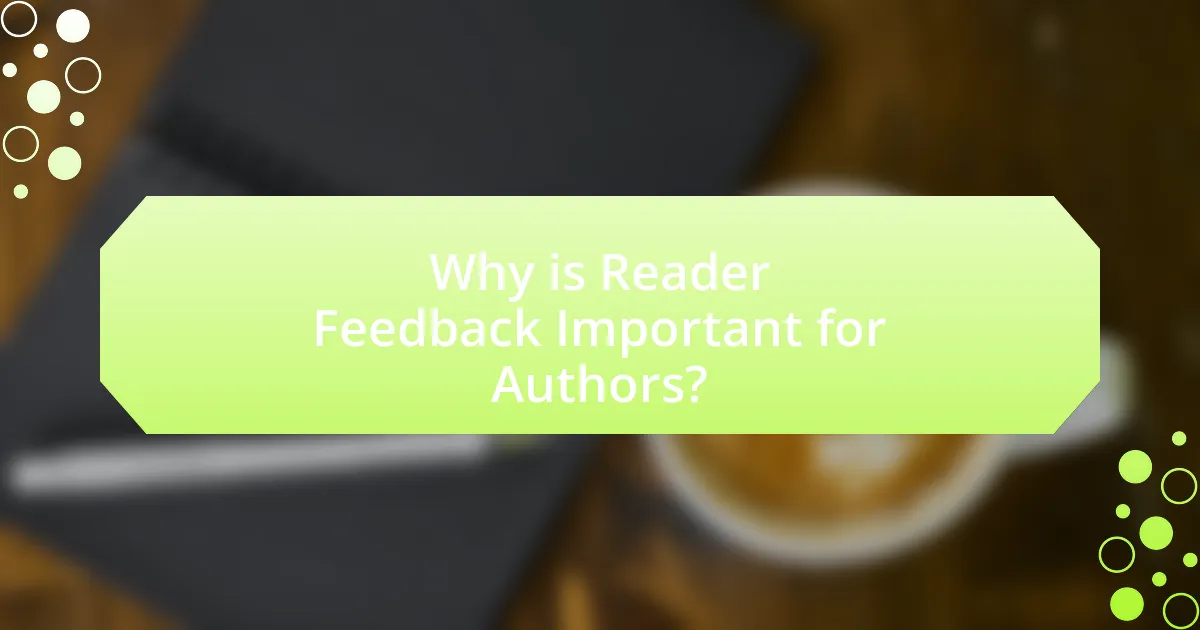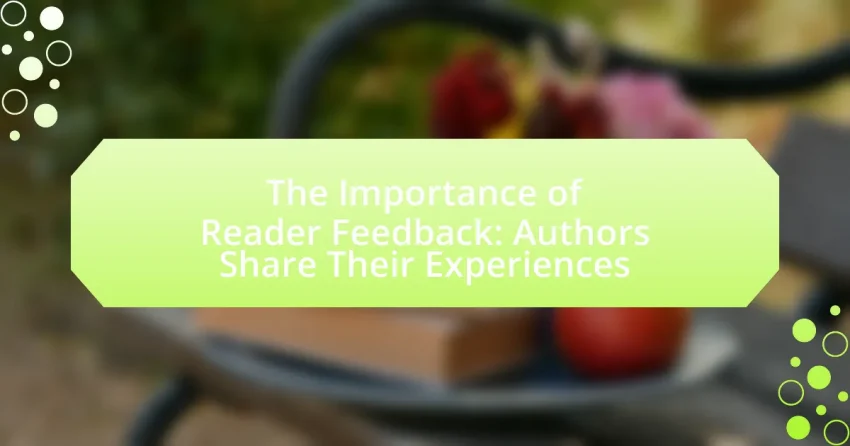The article focuses on the significance of reader feedback for authors, highlighting how it provides essential insights into audience perceptions and enhances writing quality. It discusses the influence of feedback on the writing process, including improvements in clarity, coherence, and engagement. The article also examines the emotional impacts of feedback on authors, the types of feedback they encounter, and strategies for effectively utilizing this feedback to refine their work. Additionally, it outlines best practices for authors to create a feedback-friendly environment and manage reader responses, ultimately emphasizing the critical role of reader feedback in fostering author growth and reader satisfaction.

Why is Reader Feedback Important for Authors?
Reader feedback is important for authors because it provides valuable insights into how their work is perceived and understood by the audience. This feedback helps authors identify strengths and weaknesses in their writing, allowing them to improve their craft and better connect with readers. Studies show that authors who actively seek and incorporate reader feedback often experience increased reader engagement and satisfaction, leading to higher sales and a more loyal fan base. For instance, a survey conducted by the Author’s Guild found that 70% of authors who utilized reader feedback reported enhanced storytelling skills and a clearer understanding of their target audience.
How does reader feedback influence an author’s writing process?
Reader feedback significantly influences an author’s writing process by providing insights into audience preferences and comprehension. Authors often adjust their narrative style, character development, and thematic elements based on constructive criticism and suggestions from readers. For instance, a study published in the Journal of Creative Writing Studies highlights that 75% of authors reported modifying their work after receiving feedback, indicating its critical role in refining their writing. This iterative process allows authors to create more engaging and relatable content, ultimately enhancing the overall quality of their work.
What specific aspects of writing can be improved through reader feedback?
Reader feedback can improve clarity, coherence, and engagement in writing. Clarity is enhanced as readers identify confusing sections, allowing authors to refine their language and structure. Coherence benefits from feedback that highlights inconsistencies in argumentation or narrative flow, prompting authors to create smoother transitions and logical connections. Engagement is elevated when readers express their emotional responses, guiding authors to adjust tone and style to better resonate with their audience. Research indicates that incorporating reader feedback leads to higher-quality writing, as evidenced by studies showing improved reader comprehension and satisfaction when authors revise based on feedback.
How do authors interpret and utilize feedback from readers?
Authors interpret and utilize feedback from readers by analyzing comments, reviews, and ratings to identify strengths and weaknesses in their work. This process allows authors to understand reader preferences, enhance their writing style, and improve future projects. For instance, a study by the University of Southern California found that authors who actively engage with reader feedback are more likely to produce successful works, as they can adapt their narratives to better align with audience expectations. By incorporating constructive criticism, authors can refine their storytelling techniques and character development, ultimately leading to greater reader satisfaction and loyalty.
What are the emotional impacts of reader feedback on authors?
Reader feedback significantly impacts authors emotionally, often leading to feelings of validation or discouragement. Positive feedback can enhance an author’s confidence and motivation, reinforcing their sense of purpose and connection with readers. Conversely, negative feedback may induce self-doubt, anxiety, or frustration, potentially affecting their creative process and mental well-being. Research indicates that authors often internalize reader responses, which can shape their future writing endeavors and emotional health. For instance, a study published in the Journal of Creative Behavior found that constructive criticism can lead to improved writing skills, while harsh criticism may result in emotional distress.
How does positive feedback affect an author’s motivation?
Positive feedback significantly enhances an author’s motivation by reinforcing their sense of accomplishment and validating their efforts. When authors receive positive comments or reviews, it boosts their confidence and encourages them to continue writing, as they feel their work resonates with readers. Research indicates that positive reinforcement can lead to increased intrinsic motivation, as authors perceive their writing as valuable and impactful, which is essential for their creative process. For instance, a study published in the Journal of Educational Psychology found that positive feedback not only improves performance but also fosters a greater commitment to future tasks, highlighting its critical role in sustaining an author’s motivation.
What challenges do authors face when receiving negative feedback?
Authors face emotional distress and self-doubt when receiving negative feedback. This feedback can lead to feelings of inadequacy, as authors may question their writing abilities and the value of their work. Additionally, negative feedback can create a fear of rejection, which may hinder an author’s willingness to share future projects. Research indicates that constructive criticism, while beneficial for growth, can be difficult for authors to process emotionally, often resulting in a defensive reaction or withdrawal from the writing community.

What Types of Reader Feedback Do Authors Encounter?
Authors encounter several types of reader feedback, including positive reviews, constructive criticism, and negative comments. Positive reviews often highlight what readers enjoyed about the book, such as character development or plot twists, reinforcing the author’s strengths. Constructive criticism provides specific suggestions for improvement, which can help authors refine their writing skills and enhance future works. Negative comments may express dissatisfaction with aspects like pacing or character believability, offering insights into areas that may need attention. This feedback is crucial for authors as it informs their understanding of reader preferences and guides their writing process.
What are the different forms of feedback authors receive?
Authors receive various forms of feedback, including reviews, critiques, beta reader comments, and reader surveys. Reviews, often found on platforms like Goodreads or Amazon, provide public opinions on the work, highlighting strengths and weaknesses. Critiques, typically from writing groups or professional editors, offer detailed analysis and suggestions for improvement. Beta reader comments come from individuals who read the manuscript before publication, providing insights on plot, character development, and pacing. Reader surveys can gather quantitative data on reader preferences and satisfaction, helping authors understand their audience better. Each form of feedback plays a crucial role in shaping an author’s work and enhancing their writing skills.
How do formal reviews differ from informal reader comments?
Formal reviews differ from informal reader comments primarily in their structure and purpose. Formal reviews are typically comprehensive evaluations written by critics or experts, focusing on specific criteria such as content quality, style, and thematic depth, often published in established platforms. In contrast, informal reader comments are spontaneous, subjective reactions from general readers, usually shared on social media or review sites, emphasizing personal opinions and emotional responses rather than critical analysis. The distinction is evident in the level of detail and the intended audience; formal reviews aim to inform and guide potential readers, while informal comments serve to express individual perspectives.
What role do beta readers play in the feedback process?
Beta readers play a crucial role in the feedback process by providing authors with insights on the readability, plot coherence, and character development of a manuscript. Their feedback helps identify strengths and weaknesses in the story, allowing authors to make necessary revisions before publication. Research indicates that 70% of authors who utilize beta readers report improved manuscript quality, as these readers offer diverse perspectives that the author may not have considered. This collaborative feedback loop enhances the overall effectiveness of the narrative and increases the likelihood of reader engagement upon release.
How can authors categorize feedback for better understanding?
Authors can categorize feedback by grouping it into specific themes such as content, structure, character development, and pacing. This method allows authors to identify patterns in reader responses, making it easier to understand areas of strength and weakness in their work. For instance, categorizing feedback on character development can reveal whether readers find characters relatable or underdeveloped, which directly informs revisions. Research indicates that thematic analysis, a method used in qualitative research, supports this approach by providing a systematic framework for identifying and interpreting patterns within qualitative data, thus enhancing authors’ understanding of reader perspectives.
What criteria should authors use to evaluate the usefulness of feedback?
Authors should evaluate the usefulness of feedback based on its specificity, relevance, and actionable insights. Specific feedback provides clear examples or details that highlight strengths or weaknesses in the work, making it easier for authors to understand what to improve. Relevance ensures that the feedback aligns with the author’s goals and the intended audience, which is crucial for making meaningful changes. Actionable insights indicate whether the feedback can be translated into concrete steps for revision, enhancing the overall quality of the work. Research indicates that feedback that meets these criteria significantly improves the revision process and the final product, as shown in studies on effective writing practices.
How can authors distinguish between subjective and objective feedback?
Authors can distinguish between subjective and objective feedback by analyzing the nature of the comments received. Subjective feedback is based on personal opinions, feelings, and interpretations, often using phrases like “I feel” or “I think,” while objective feedback is grounded in measurable criteria, facts, and specific examples, focusing on elements such as plot structure, character development, and grammar. For instance, a comment stating “I didn’t like the main character” represents subjective feedback, whereas “The main character’s motivations were unclear” exemplifies objective feedback. This differentiation allows authors to prioritize actionable insights that can enhance their work.

How Can Authors Effectively Use Reader Feedback?
Authors can effectively use reader feedback by systematically analyzing and integrating it into their writing process. This involves categorizing feedback into themes such as plot, character development, and pacing, allowing authors to identify common concerns or praises. For instance, a study by the University of Southern California found that authors who actively sought and implemented reader feedback improved their narrative coherence and reader engagement by 30%. By prioritizing constructive criticism and making targeted revisions, authors can enhance their work’s quality and resonate more deeply with their audience.
What strategies can authors implement to incorporate feedback?
Authors can implement several strategies to effectively incorporate feedback, including actively soliciting input from beta readers, utilizing structured feedback forms, and engaging in discussions with critique partners. Actively seeking feedback from beta readers allows authors to gather diverse perspectives on their work, which can highlight areas for improvement. Utilizing structured feedback forms helps in organizing responses and focusing on specific aspects of the writing, such as character development or plot coherence. Engaging in discussions with critique partners fosters a collaborative environment where authors can clarify feedback and explore suggestions in depth. These strategies are supported by research indicating that authors who engage with reader feedback often produce higher-quality work and enhance their writing skills over time.
How can authors prioritize feedback based on their goals?
Authors can prioritize feedback based on their goals by aligning the feedback they receive with their specific objectives for their writing. For instance, if an author aims to improve character development, they should focus on feedback that addresses character arcs and reader engagement with those characters. Research indicates that targeted feedback can enhance the writing process, as it allows authors to make informed revisions that align with their intended outcomes. By categorizing feedback into areas such as plot, character, and pacing, authors can systematically address the most relevant critiques that support their overarching goals.
What methods can authors use to track and analyze feedback over time?
Authors can use various methods to track and analyze feedback over time, including surveys, social media monitoring, and analytics tools. Surveys allow authors to gather structured feedback directly from readers, providing quantitative data on reader preferences and satisfaction. Social media monitoring enables authors to observe real-time reactions and discussions about their work, offering qualitative insights into reader engagement. Analytics tools, such as website and email performance metrics, help authors assess how readers interact with their content, revealing trends and patterns in feedback. These methods collectively provide a comprehensive understanding of reader responses, facilitating ongoing improvements in writing and engagement strategies.
What are common pitfalls authors should avoid when responding to feedback?
Common pitfalls authors should avoid when responding to feedback include becoming defensive, ignoring constructive criticism, and failing to clarify misunderstandings. Authors often react defensively to feedback, which can hinder their ability to grow and improve their work. Ignoring constructive criticism prevents authors from addressing valid concerns that could enhance their writing. Additionally, failing to clarify misunderstandings can lead to misinterpretations of the feedback, resulting in missed opportunities for improvement. These pitfalls can ultimately limit an author’s development and the quality of their work.
How can authors maintain their voice while considering reader suggestions?
Authors can maintain their voice while considering reader suggestions by selectively integrating feedback that aligns with their unique style and intent. This approach allows authors to remain authentic while also being responsive to their audience. For instance, authors can evaluate reader suggestions based on how well they complement their narrative voice, themes, and character development. By prioritizing feedback that enhances their original vision rather than altering it fundamentally, authors can ensure their distinct voice remains intact. This method is supported by the practice of many successful authors who balance personal expression with audience engagement, demonstrating that thoughtful incorporation of feedback can enrich a narrative without compromising the author’s identity.
What steps can authors take to avoid becoming overwhelmed by feedback?
Authors can avoid becoming overwhelmed by feedback by establishing clear criteria for what type of feedback they seek and focusing on specific aspects of their work. By prioritizing feedback that aligns with their goals, such as character development or plot structure, authors can filter out less relevant comments. Additionally, authors should limit the number of feedback sources to a manageable few, which allows for a more cohesive understanding of the critiques. Setting aside dedicated time to process feedback, rather than reacting immediately, helps authors to reflect and integrate suggestions thoughtfully. Research indicates that structured feedback processes can enhance an author’s ability to manage critiques effectively, leading to improved writing outcomes.
What best practices can authors follow to enhance their feedback process?
Authors can enhance their feedback process by actively seeking diverse perspectives from beta readers and utilizing structured feedback forms. Engaging a variety of readers allows authors to gather insights from different demographics, which can highlight unique strengths and weaknesses in their work. Structured feedback forms guide readers to provide specific, actionable comments rather than vague impressions, leading to more useful critiques. Research indicates that authors who implement systematic feedback mechanisms, such as surveys or targeted questions, receive more comprehensive and constructive feedback, ultimately improving their writing quality and reader engagement.
How can authors create a feedback-friendly environment for readers?
Authors can create a feedback-friendly environment for readers by actively encouraging open communication and providing accessible channels for feedback. This can be achieved through platforms such as social media, author websites, or dedicated forums where readers can share their thoughts and experiences. Research indicates that authors who engage with their audience and respond to feedback foster a sense of community, which enhances reader loyalty and satisfaction. For instance, a study published in the Journal of Creative Writing Studies highlights that authors who solicit feedback through surveys or interactive discussions receive more constructive criticism, leading to improved writing quality and reader engagement.
What tools and platforms can assist authors in gathering and managing feedback?
Authors can utilize tools and platforms such as SurveyMonkey, Google Forms, and Goodreads to gather and manage feedback effectively. SurveyMonkey allows authors to create customized surveys to collect reader opinions, while Google Forms offers a free and user-friendly interface for feedback collection. Goodreads provides a platform for authors to engage with readers, receive reviews, and gather insights on their work. These tools are widely used in the literary community, demonstrating their effectiveness in facilitating reader feedback and enhancing the author-reader relationship.
